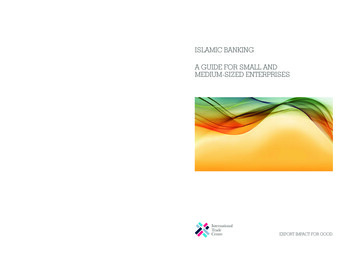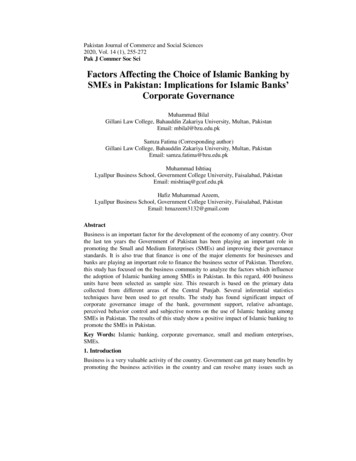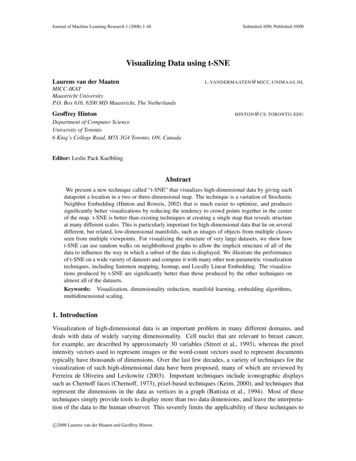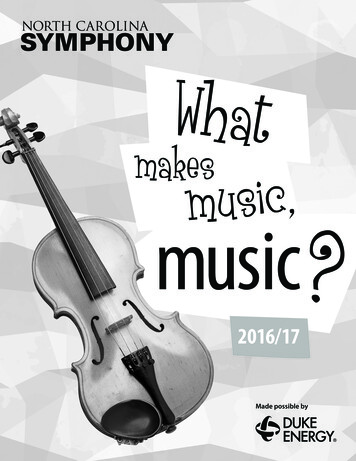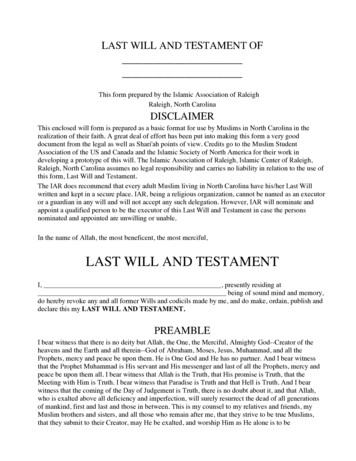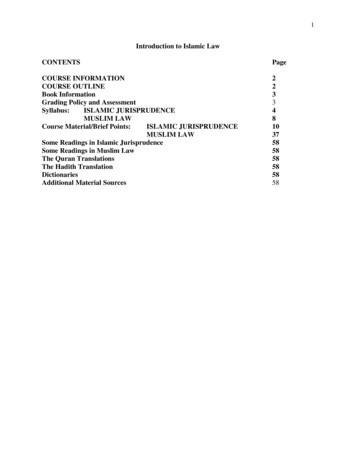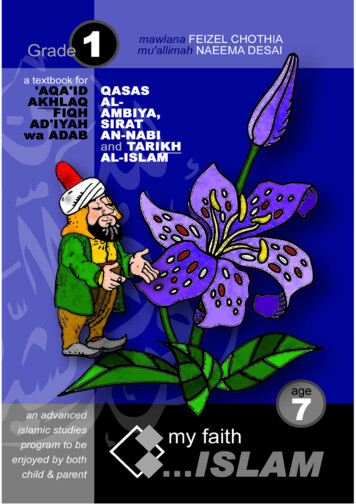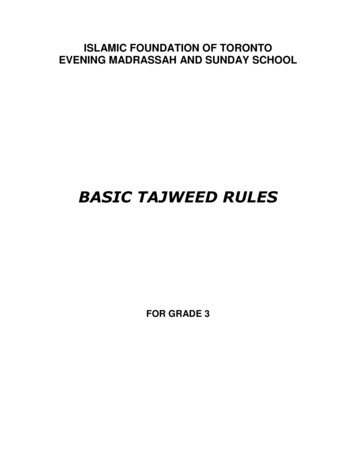
Transcription
ISLAMIC FOUNDATION OF TORONTOEVENING MADRASSAH AND SUNDAY SCHOOLBASIC TAJWEED RULESFOR GRADE 3
Table of ContentsIntroduction .3Etiquettes of Reading Qur'an . 4Revision of Last Years . 7Lesson 1Similar Sound Letters. 6Lesson 2Makhaarij . 16Lesson 3Letters of Mustaliyah . .Lesson 4Letters of Madd . . 27Lesson 5Qalqalah . 29Lesson 6Types of Madd 31Lesson 7Noon Kitney 33Lesson 8Silent Letters .35Basic Tajweed Rules Grade 325Page 2
IntroductionTajweed means to recite every letter of the Qur'an correctly from its makhraj with all ofits qualities. The importance of tajweed can't be denied as reciting the Qur'an withouttajweed will not only effect the beauty of the Qur'an but sometimes it can change themeaning of the Qur'an.For example: The word Qalb means "heart". If instead of Qaaf, Kaaf is read themeaning changes to "dog". The word "Rahim" used for Allah, means 'very merciful'.If instead of ( )ح letter ( )ﻫ is read the meaning changes to " thirsty camel".It is therefore compulsory (fardh) on each and every Muslim male or female to learntajweed so that he or she can recite correctly.In this book the basic rules of tajweed are explained in a simple way so that thestudents of grades 3 - 5 can understand and memorize the tajweed rules easily.After learning and understanding these rules the students will inshaallah be able torecite the Qur'an correctly with tajweed.However, to read the Qur'an correctly with tajweed it is not enough to understand onlythe rules of tajweed but it is also necessary to practice these rules with an expertteacher.All praise is for Allah tabarak ta'ala who is our lord and our creator who enlightened uswith the Noor of Iman and made us Muslim and include us in the ummah of our belovedprophet Khatimul Ambiah, Muhammadur Rasulullah (SAW).This book is prepared by the teachers of Islamic Foundation of Toronto. May Allahreward them in this life and the hereafter.Basic Tajweed Rules Grade 3Page 3
Etiquettes of Reading Qur'an1. Perform wudhu. It is a sin to touch the Qur'an without wudhu.2. It is permissible to read the Qur'an from memory without wudhu (without touching it)3. A person in a state of haidh, nifaas or janabat is not allowed to read any verse of theQur'an with or without memory and is not allowed to touch the Qur'an.4. Sit with great respect when reading the Qur'an.5. Begin the Qur'an with Ta-awwuz .ُ اَع ُْو ُذ and Tasmiyah . ُلَا ُِّ َ ِبسْ ِم 6. One must not talk during reading Qur'an. If an important matter has to be discussedwith anyone then the reading should be stopped and the Qur'an should be closed.7. If one has spoken while reading Qur'an (due to some important reason) then reciteTa-awwuz only before restarting.8. The reader should have this in mind that these are the words of Allah and Allah islistening to how I am reading his book.9. Read Tasmiyah before start of a new surah except surah Tawbah.10. Do not put the Qur'an on the carpet or any place on which people stand or sit.11. Do not put any book or object on top of the Qur'an.12. Do not have your back to the Quran or somebody else's back towards the Qur'an.13. If one feels tired and begins to yawn while reading the Qur'an, then stop the recitationand continue after you have rested.14. Do not sit on a place which is higher than the Qur'an.15. Do not sleep with your feet towards the Qur'an.16. It is sinful to carelessly discard, torn or worn pages of the Qur'an. Do not throw themin the garbage can.Basic Tajweed Rules Grade 3Page 4
Guideline For the Teacher: Practice and listen to the Pronunciation of 5 letters fromevery student in each tajweed class.Basic Tajweed Rules Grade 3Page 5
LESSON 1Similar Sound LettersPractice the letters in the first row with letters in the 2nd and 3rd row that are different inpronunciation but have a similar sound.Basic Tajweed Rules Grade 3Page 6
REVISION OF LAST YEARSFULL MOUTH LETTERS1. There are 7 full mouth letters2. Full mouth letters are always read with full mouth with a heavy sound.THROAT LETTERS1. There are 6 throat letters2.andare pronounced from the bottom of the throat nearest to the chest.3.and4.andare pronounced from the middle of the throat.are pronounced from the top of the throat nearest to the mouth.HARAKAAT1. Fatha , Dhammah and Kasra are called Harakaat.2. Harakaat letters are read quickly with no stretch or jerk.HAMZAH ()1. When Alif has got anything, it is called a Hamzah.َ ُا Example: Hamzah Fatha ( )Hamzah Fatha Madd ( )ُ ْا Hamzah Sakin ( )ُ ْا 2. Hamzah sakin ( ) is read with a slight twitch (jerk).Example:َ َق َر ْا ُ ب َ ْ َيا - ُْ َو ْامُر - ُ ت Basic Tajweed Rules Grade 3Page 7
TANWEEN1. Fathatain, dhammatain and kasratain are called Tanween.2. Tanween letters are read from the nose.SAKIN1. A letter with Jazam (sukoon) is called sakin.Example: Waaw Sakin (ُْ ) و Meem Sakin (ُ ) ْم Noon Sakin (ُْ ) ن 2. Sakin is read once by joining it to the letter before it.Example:ُْ اَن - عِ ُْد - ل ُْ ُ ق QALQALA1. To read a letter with a bouncing sound is called Qalqala.2. There are 5 letters of Qalqala3. When any Qalqala letter is sakin, Qalqala should be made.Example:ُْ ُتب - عِ ُْد - َخلَق Basic Tajweed Rules Grade 3Page 8
LETTERS OF MADD (HUROOFUL MADDAH)1. There are 3 letters of Madd ا , و and ى .2. Alif is maddah when there is fatha before Alif.Example: ُ َثا -ُ ُ َتا -ُ َبا 3. Waaw is maddah when there is dhammah before Waaw sakin.Example:ُْ ُثو -ُ ُ ُت ْو -ُ ب ُْو 4. Yaa is maddah when there is kasra before Yaa sakin.Example:ُْ ُثِى -ُ ْ ُ ِتى -ُ ْ ِبى 5. Maddah letters are read by stretching one Alif (1sec).Note: 1 Alif is the time required in closing or opening of a finger normally.FATHA MADD, DHAMMAH MADD AND KASRA MADD1. Fatha Madd ( ) is in place of Alif Maddah.Exmaple: Baa Fatha Madd Baa Alif Fatha َبا 2. Dhammah Madd ( ) is in place of Waaw Maddah.Example: Waaw Dhammah Madd Waaw Waaw Dhammahُْ وُ و 3. Kasra Madd ( ) is in place of Yaa Maddah.Example: Haa Kasra Madd Haa Yaa Kasraُْ هِى 4. Fatha Madd, Dhammah Madd and Kasra Madd are stretch for 1 Alif (1sec).Basic Tajweed Rules Grade 3Page 9
LETTERS OF LEEN1. There are 2 letters of Leen و and ى .2. Waaw is Leen when there is fatha before Waaw sakin.ُْ ُ َتو -ُ ُ َب ْو -ُ اَ ْو Example:3. Yaa is Leen when there is fatha before Yaa sakin.Example:ُْ ُ َتى -ُ ْ ُ َبى -ُ ْ اَى 4. Leen letters are read softly and quickly.TASHDEED (SHADDAH)1. Tashdeed (Shaddah) looks like “ ”.2. A letter with a tashdeed is called “Mushaddad”.Example: Ba Mushaddad (ُّ ) ب Meem Mushaddad (ُ ) ّم .3. Mushaddad letters are read twice (First time by joining it to the letter before it,and the second time on itself according to its own harakat).Example:ُ ُ َق َّل -ُ ُ َم َّد -ُ َّ َرب 4. All mushaddad letters, except Noon and Meem mushaddad should be read hardwith force.GHUNNAH1. To read a letter with a full nasal sound is called “Ghunnah”.2. There are two letters of ghunnah ن and م .3. Noon and Meem are read with Ghunnah when they have a tashdeed.Example:َُّ ُ َظن -ُ َّ ُاِن -ُ َع َّم 4. The duration of ghunnah is one Alif (1sec).Basic Tajweed Rules Grade 3Page 10
RULES OF RAA ()1. A Raa with fatha, dhammah, fathatain, dhammatain will be read with full mouth.Example:---2. A Raa with a kasra or kasratain under it will be read with empty mouth.Example:--3. A Raa sakin with fatha or dhammah before it, will be read with full mouthExample:-4. A Raa sakin with kasra before it, will be read with empty mouthExample:-5. A Raa sakin with Yaa sakin before it will always be read with empty mouthExample:--6. A Raa mushaddad with fatha, dhammah, fathatain or dhammatain will be readwith a full mouth.Example:7.-A Raa mushaddad with a kasra or kasratain will be read with an empty mouth.Example:-8. A Raa sakin with a “Full Mouth Letter” appearing in the same word after it, will beread with full mouthExample:Basic Tajweed Rules Grade 3Page 11
RULES OF NOON SAAKIN AND TANWEENThere are 4 rules of Noon saakin and tanween.1. IZHARIzhar means to read a letter clearly from its makhraj without ghunnah.Rule: If after Noon Saakinor Tanweenthroat lettersthere appears any of the six, Noon Saakin or Tanween will be read withoutghunnah.Example:--2. IDGHAAMIdgham means to enter one thing into another.There are six letters of IdghaamRule: If after Noon Saakin or Tanween there appears any of the six letters of, Idgham will take place.In four lettersIdghaam will be with Ghunnah.Example:--In two letters Laam and Raa, Idghaam will be without Ghunnah.Example:-3. QALB (IQLAAB)Qalb means to change one thing into another.Rule: If after Noon Saakin or Tanween there appears letter Baa then Noon Saakinor Tanween will be changed into Meem and read with Ghunnah.Example:-Basic Tajweed Rules Grade 3-Page 12
4. IKHFAIkhfa means to hide (conceal).There are 15 letters of IkhfaRule: If after Noon Saakin or Tanween there appears any of the 15 letters ofIkhfa, Noon Saakin or Tanween will be read with the quality of Ikhfa.Example:-Note: The difference between Ghunnah and Ikhfa is that in Ghunnah full soundcomes from the nose where as in Ikhfa only a light sound comes from nose.RULES OF MEEM SAAKIN1. If after Meem Saakin there appear another Meem or letter Baa then MeemSaakin will be read with Ghunnah.Example:--2. If after Meem saakin there appears any letter other than Meem or Baa, thenMeem saakin will be read without Ghunnah.Example:Basic Tajweed Rules Grade 3-Page 13
RULES OF LAAM OF THE WORD ALLAH1. If fatha or dhammah appears before the word Allah, the Laam in the word Allahwill be read with full mouth.Example:--2. If kasra appears before the word Allah, the Laam in the word Allah will be readwith empty mouth.Example:-3. In all other places Laam is read with empty mouth.RULES OF WAQF1. Waqf means” stop”.2. When waqf is made on last letter of a word which has a harakat, kasratain,dhammatain, kasra madd and dhammah madd, then the last letter is madesaakin.Example:-----3. If the last letter has a fathatain, take out one fatha and read the Alif after it. Ifthere is no Alif, add and Alif.Example:--4. Waqf on Alif Maddah and Fatha Madd will remain the same.Example:-5. When waqf (stop) is made on a round ة it will change into small ُْه saakin.Example:ُْ َج َّنه ُ َج َّنه 6. Waqf (stop) on hamzah which is saakin dur to waqf, will be read with jerk.Example:-7. Waqf on Noon and Meem mushaddad will be made with ghunnah.Example:-Basic Tajweed Rules Grade 3Page 14
SYMBOLS OF WAQFSYMBOLEXPLANATIONAayah (Completion of a sentence) - Stop م Waqf-e-Laazim – Must Stop here. ﻁ Waqf-e-Mutlaq – It is necessary to stop here. ال Don’t stop here. ُسكته -ُ س Pause for a moment without breaking the breath.Basic Tajweed Rules Grade 3Page 15
LESSON 2MAKHAARIJMakhraj is the place where the sound of a letter originates. There are 17 makhaarij for29 Arabic letters.Makhraj is singular and Makhaarij is plural.The makhaarij of 29 Arabic letters are explained as under.1. –ا 2. – ب Baa is pronounced from the moist part of the lips.3. –ت Alif is pronounced from the emptiness of the mouth.Taa is pronounced when the tip of the tongue touches the roots of theupper 2 front teeth.4. –ث Thaa is pronounced when the tip of the tongue touches the edge of theupper 2 front teeth.5.6.7. –ج –ح –خ Jeem is pronounced when the centre of the tongue touches the palate.Haa is pronounced from the middle of the throat.Khaa is pronounced from the top of the throat which is nearest to themouth.8. –د Daal is pronounced when the tip of the tongue touches the roots of theupper 2 front teeth.9. –ذ Zaal is pronounced when the tip of the tongue touches the edge of theupper 2 front teeth.Basic Tajweed Rules Grade 3Page 16
10. –ر Raa is pronounced when the edge of the tongue touches the gums of theupper 4 front teeth.11. –ز Zaa is pronounced when the tip of the tongue touches the edge of thelower 2 front teeth and lightly touches the edge of the upper 2 front teeth.12. –س Seen is pronounced when the tip of the tongue touches the edge of thelower 2 front teeth and lightly touches the edge of the upper 2 front teeth.13.14. –ش –ص Sheen is pronounced when the centre of the tongue touches the palate.Suad is pronounced when the tip of the tongue touches the edge of thelower 2 front teeth and lightly touches the edge of the upper 2 front teeth.15. –ض Dhuad is pronounced from the upturned, back edge of the tongue whentouching the roots of the Molars and Premolars.Note: There are 3 ways of pronouncing Dhuad.a) From the right side.b) From the left side.c) From both sides.It is easier to pronounce Dhuad from the left side.16. –ط Taw is pronounced when the tip of the tongue touches the roots of theupper 2 front teeth.17. –ظ Zaw is pronounced when the tip of the tongue touches the edge of theupper 2 front teeth.18.19. –ع –غ Ain is pronounced from the middle of the throat.Ghain is pronounced from the top of the throat which is nearest to themouth.Basic Tajweed Rules Grade 3Page 17
20. –ف Faa is pronounced when the inner portion of the lower lip meets the edgeof the upper two front teeth.21. –ق Qaaf is pronounced when the extreme back of the tongue touches thepalate.22.23. –ك –ل Khaf is pronounced when the back of the tongue touches the palate.Laam is pronounced when the edge of the tongue touches the gums ofthe upper 8 front teeth.24.25. –م –ن Meem is pronounced when the dry part of both lips meet.Noon is pronounced when the edge of the tongue touches the gums of theupper 6 front teeth.26.27. –و –ه Wow is pronounced when both lips meet incompletely.Haa is pronounced from the bottom of the throat which is nearest to thechest.28. –ء Hamza is pronounced from the bottom of the throat which is nearest to thechest.29. –ي Yaa is pronounced when the centre of the tongue touches the palate.Basic Tajweed Rules Grade 3Page 18
How to find the Makhraj of a letterTo find makhraj of a letter, make the letter saakin and put an Alif with a Fatha before it.The place where the sound ends will be the makhraj of that letter.For Example: To find makhraj of letter Baa, ُْ اَب will give its makhraj.Things to Remember1. The makhraj of letters ي , ش , ج is the same.2. The makhraj of letters ط , د , ت is the same.3. The makhraj of letters ظ , ذ , ث is the same.4. The makhraj of letters ص , س , ز 5. The makhraj of letters ه , ء 6. The makhraj of letters ح , ع 7. The makhraj of letters خ , غ 8. The makhraj of letteris the same.is the same.is the same.is the same. ر is the edge of the tongue when touching the gums of the ن is the edge of the tongue when touching the gums of theupper 4 front teeth.9. The makhraj of letterupper 6 front teeth.10. The makhraj of letter ل is the edge of the tongue when touching the gums of theupper 8 front teeth.Basic Tajweed Rules Grade 3Page 19
Basic Tajweed Rules Grade 3Page 20
QUESTIONSQ1. Fill in the blanks.1) Makhraj is the place where the .2) There are makhaarij for Arabic Alphabets.3) The letter ا 4) The letter ب 5) The lettersis pronounced from theis pronounced from the ط , د , ت are pronounced when the6) The letters ظ , ذ , ث are pronounced when the7) The letters ي , ش , ج are pronounced when the8) The letters ح , ع are pronounced from theBasic Tajweed Rules Grade 3Page 21
9) The letters خ , غ are pronounced from the10) The letter ر is pronounced when the11) The letters ص , س , ز are pronounced from the12) The letter ض is pronounced from the13) The letter ف is pronounced when the14) The letter ق is pronounced when theBasic Tajweed Rules Grade 3Page 22
15) The letter ك is pronounced when the16) The letter ل is pronounced when the17) The letter م is pronounced when the18) The letter ن is pronounced when the19) The letter و 20) The lettersis pronounced when ه , ء are pronounced from theBasic Tajweed Rules Grade 3Page 23
Q2. What other letters have the same makhraj as?i. ج ii. ت iii. ث iv. ز v. ء vi. ع vii. غ Basic Tajweed Rules Grade 3Page 24
LESSON 3LETTERS OF MUSTA’LIYAH (FULL MOUTH LETTERS)There are 7 letters of Musta’liyahThese seven letters are always read Mufakh’kham (full mouth) with heavy sound inevery condition. Musta’liyah letters are therefore also known as Mufakh'kham letters orHuroofe-Tafkheem.Basic Tajweed Rules Grade 3Page 25
QUESTIONSQ1. What are the “Letters of Musta’liyah”?Q2. How are letters of Musta’liyah read under all conditions?Q3. Why lettes of Musta’liyah are also called Huroofe-Tafkheem?Q4. Circle letters of Musta’liyah in the following words.Basic Tajweed Rules Grade 3Page 26
LESSON 4LETTERS OF MADD (HUROOFUL MADDAH)There are 3 letters of Madd ا , و , ى .These letters will be letters of Madd when;1. Alif has a letter with a fatha before it.2. Waaw is saakin and it has a letter with a dhammah before it.3. Yaa is saakin and it has a letter with a kasra before it.Letters of Madd are read by stretching one Alif (1 Alif is the time required in closing oropening of a finger normally).Note:1. Fatha Madd ( ) is in place of Alif Maddah.2. Dhammah Madd ( ) is in place of Waaw Maddah.3. Kasra Madd ( ) is in place of Yaa Maddah.4. Therefore Fatha, Dhammah and Kasra Madd will also be stretch one Alif.Basic Tajweed Rules Grade 3Page 27
QUESTIONSQ1. What are the letters of Madd?Q2. When is ا a letter of Madd? Give example.Q3. When is و a letter of Madd? Give example.Q4. When is ى a letter of Madd? Give example.Q5. How will the letters of Madd be read?Q6. What is one Alif?Q7. What is in place of Alif Maddah?Q8. What is in place of Waaw Maddah?Q9. What is in place of Yaa Maddah?Basic Tajweed Rules Grade 3Page 28
LESSON 5QALQALAHQalqalah is a quality, which when pronounced, appears to have an bouncing sound,when the letter is saakin.Note: Care should be taken so that the bouncing sound does not reach an extent whereit becomes a Harkat (Fatha, Dhammah, Kasrah) or Tashdeed.There are 5 letters of QalqalahBasic Tajweed Rules Grade 3Page 29
QUESTIONSQ1. What does Qalqalah means?Q2. What are the letters of Qalqalah?Q3. When will Qalqalah be made? Give example.Q4. Read and Circle the letters to be read with Qalqalah in the following words.--Basic Tajweed Rules Grade 3--Page 30
LESSON 6TYPES OF MADDMadd means to stretch.There are two types of Madd.1. Maddul Asli 2. Maddul Far’ie1. MADDUL ASLIIf after any letter of Madd (,,) there is no hamzah or jazam (sukoon) ortashdeed, then the letter of Madd will be stretched for one Alif. This Madd is calledMaddul Aslee.ُ َك ِريْم ُ اَع ُْو ُذ ُ ح ُْور ُ اف َ َخ ُ َقا َل Note: The time it would take to close or open a finger normally is the length of 1 Alif.2. MADDUL FAR’IEIf after any letter of Madd, there is a hamzah or sukoon or tashdeed, then the letterof Madd will be stretched for 3 to 6 Alif. This Madd is called Maddul Far’ie.Basic Tajweed Rules Grade 3Page 31
QUESTIONSQ1. What is the meaning of Madd?Q2. What are the types of Madd?Q3. Explain Maddul Asli?Q4. How long we stretch Maddul Asli?Q5. What is one Alif?Q6. Explain Maddul Far’ie?Basic Tajweed Rules Grade 3Page 32
LESSON 7NOON KITNEY1. If after tanween there is a saakin or mushadad letter and waqf is not desired (wewant to continue), then one harakat of tanween will be taken out and akasra is put to join the next letter.ThisExample:ْ ً َخيْر ُ اال َوصِ َّي ُة لُ َم َزةٍالَّذِى with ais called Noon-e-Kitney.will be read aswill be read as2. If waqf is made on the tanween letter then Noon Kitney will not be pronounced.Example: لُ َم َزةٍالَّذِى Basic Tajweed Rules Grade 3will be read لُ َم َزهُْ اَلَّذِى Page 33
QUESTIONSQ1. Explain Noon Kitney?Q2. How are we going to read the following two aayah, with and without Waqf?Q3. How are we going to put Noon Kitney to join the two words in the followingexamples. لُ َم َزةٍالَّذِى ْ ً َخيْر ُ اال َوصِ َّي ُة Basic Tajweed Rules Grade 3Page 34
LESSON 8SILENT LETTERS1. In many places in Quran the letters Alif, Waaw and Yaa are written but not read.2. A silent letter is a letter that is written but not read. Any letter that has nothing onit e.g harakaat, jazam or tanween etc. is silent.Examples of Waaw silentExamples of Yaa silent ُه ًدى ُ ط ًوى Examples of Alif silentْ َم ُ ار َع ُة ِ اال َق َرض ُْوا ُْ َوا ْن َحر 3. The Alif which is silent in Quran and is not supposed to read is sometimes put asmall circle over the Alif. However in case of waqf (stop) this Alif will be read. اَويَعفُ َوا ْ لَ ِك َّنُا 4. At some places in Quranُ َن ْدع َُو ْا ُ اري َْر ْا ِ َق َو ُ َال is written but read as َُل . Here one should be verycareful while reading as it changes the meaning.Basic Tajweed Rules Grade 3Page 35
QUESTIONSQ1. What is a silent letter? Give example.Q2. What you understand by looking a small circle over the Alif in Quran? Give example.Q3. Give any examples in Quran where the Alif in the wordُ َال is not read?Basic Tajweed Rules Grade 3Page 36
tajweed so that he or she can recite correctly. In this book the basic rules of tajweed are explained in a simple way so that the students of grades 3 - 5 can understand and memorize the tajweed rules easily. After learning and understanding these rules the students will inshaallah be able to recite the Qur'an correctly with tajweed.
